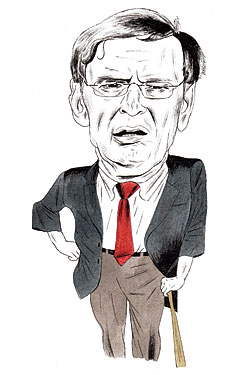
Making fun of Major League Baseball commissioner Bud Selig is so much fun it’s kind of a sport unto itself. Selig has the hangdog countenance of a man who has spent most of his life fending off wedgies, prying himself out of lockers he was stuffed into, and peeling off KICK ME signs taped to his back. The man just has a Mr. Magoo feel to him, like he is perpetually walking into situations that he somehow finds a way to bungle. If you were to invite him over for dinner, by the end of the night all your nice china would be broken, your carpet would be covered in pasta sauce, and he would have accidentally unhooked your grandfather’s oxygen tank. And he’d stand there with the same look he had on his face at the end of the 2002 All-Star Game—the one that ended in a tie because they ran out of pitchers—that “Who, me?” befuddled slack jaw. He is a man of slumped shoulders, hidden in a suit that’s too big for him, wearing a clip-on tie covered in mustard stains.
Days before NFL commissioner Roger Goodell destroyed a large swath of his and his league’s credibility with a bizarre, contradictory, nonsensical editorial in The Wall Street Journal arguing the league’s “case” against the players—following a judge’s ruling last week against the NFL’s lockout—Michael Weiner, the executive director of the baseball-players union, said this about his interactions with Selig to the New York Times: “There is a healthy amount of mutual respect, not just for each other but for the collective-bargaining process. I think what we learned from all of the disputes and work stoppages we had in the past is to respect the bargaining process. I think the view of the commissioner now is that he sees we can play a positive role.”
In this age of labor strife—the NBA’s impending lockout, which is a virtual certainty (“It’s happening,” Carmelo Anthony told me in an interview a couple of weeks ago), may be even more destructive than the NFL’s—this is an astounding statement of goodwill for a union chief to make, particularly when one considers baseball’s tortured labor history. The reason baseball has labor peace, with a collective-bargaining agreement expected to be easily renewed this December, is that Selig, of all people, has spent the past decade setting up a system that somehow makes both players and owners happy. This is because baseball is making more money than it ever has and is set up to make even more.
For all the talk of the supposed “golden age” of baseball’s being years in the past—thanks largely to baby-boomer faux mythmakers in the Ken Burns–Bob Costas mode, trying to convince us there was once a time when athletes were perfect role models who all just drank Ovaltine and helped elderly women across the street—there are more people watching baseball right now than at any time in human history. Attendance may be slightly down so far this season, but that’s in large part because baseball, unlike the other sports, has made it so easy to watch games at your computer, at home, or on your phone. (The example I always use: When Roger Maris hit his 61st homer, on October 1, 1961, at Yankee Stadium, which held 67,000 people, only 23,154 were there, most of them gathered in right field, hoping to catch it and collect the $5,000 reward. Almost every game this year at Citi Field, home of the woeful Mets, has had a higher attendance, and that’s not counting the millions of people watching away from the park.)
And Selig has made this profitable. Perhaps his greatest financial achievement was one he slipped in the back door. In 2000, when mlb.com redirected you to the website of a Philadelphia law firm, Selig pooled a $75 million investment from the league’s 30 teams into MLB Advanced Media, with the insistence that all revenue from the site be split equally. The teams made their money back in three years, and in 2010, MLBAM—whose online-video infrastructure is so powerful now that it’s paid to run other sites’ video offerings, including those of competitors like ESPN—brought in an estimated $450 million in revenue. (MLB has reportedly turned down offers of up to $1 billion in private-equity investments from venture capitalists, preferring to own MLBAM itself.) Most important, this income is spread evenly among all teams: The Pirates and Marlins receive as much as the Yankees do. To the Yankees, that’s not much money, but to the smaller-market teams, it’s a huge chunk of their payroll. And that revenue is only going to grow. It’s not NFL-style payroll parity just yet, but it’s revenue-sharing in a way that baseball has never been able to work out in the past.
Whatever your thoughts on the wild card, interleague play, and even the MLB Network, they’ve all been profitable for baseball as well. Selig, thanks to his ultraselective vetting of new owners (sorry, Mark Cuban, but if you don’t have a friend in MLB offices, you’re not getting in), has fostered unprecedented unanimity among the game’s 30 disparate owners; unlike in the NFL, the flowing cash has kept owners content rather than bloodthirsty. (Or at least not too bloodthirsty.) Baseball, unlike football, does not have a golden-goose problem. And the players, who have guaranteed contracts, pension plans, generous medical plans, and the kind of job security you see in no other league, are happy too. This has all been done in nine years. In 2002, baseball was heading toward a labor disaster the same way the NFL and the NBA currently are. It was averted. Now the sport everyone loves to complain about—including its fans; mostly its fans—is more stable than any other. It’s grand alchemy.
The cash, of course, makes a big difference. How’s this: The MLB is close to passing the NFL—the supposed Goliath of American sports—in total revenue, last year reaching $6.6 billion for 2009, just behind the NFL’s $8 billion. In 2000, baseball’s revenue was half that. Baseball is catching up. And it’s doing it stealthily, while achieving labor peace and competitive balance, with nine different champions in the past ten years.
It hasn’t all been backroom deals, either. Confident because of his recent successes, Selig is starting to take charge more over the owners, particularly in the case of the Los Angeles Dodgers. One of Selig’s rare mistakes of the past few years was allowing Frank McCourt, a highly leveraged, not nearly wealthy enough real-estate developer, to buy the Dodgers. McCourt, already short on cash, then went through a nasty divorce and, in order to make payroll, took a loan from Fox, the team’s television partner. Seeing a potential disaster brewing, Selig took control of the Dodgers, reclaiming some stability for one of baseball’s signature franchises. Compare this to the way Goodell has allowed the Buffalo Bills to twist in the wind, with the aging owner’s family batting their eyes seductively at Los Angeles, or, even worse, the way NBA commissioner David Stern treated Seattle when it lost its team to Oklahoma City or the way he’s treating poor Sacramento now. Goodell and Stern stood idly by or even assisted in the heists. Selig stepped in to help. That’s not something he does willy-nilly, mind you; he has wisely stayed mostly out of the Mets-Wilpon-Madoff mess, other than assuring that payroll will be met as the issue sorts itself out in the courts.
Bud Selig will always be a polarizing figure. Baseball fans fall into two camps: those who think he is a malevolent idiot and those who think he is merely an idiot. (And don’t get me started on the proposal to add a second wild-card team.) But when you clear out the public-relations gaffes and the ugly ties, Goodell and Stern would love to be in Selig’s position right now, with happy owners, happy players, and more fans than ever. Yep, ole Bud had a few tricks up his sleeve after all, even if that sleeve belongs to a twenty-year-old off-the-rack suit from Sears covered in taco sauce. He’s a slob like a fox.
You can write to Leitch at will.leitch@nymag.com.
